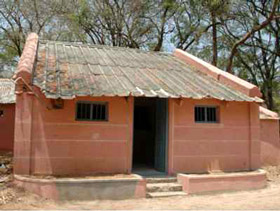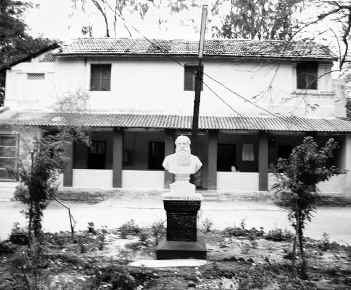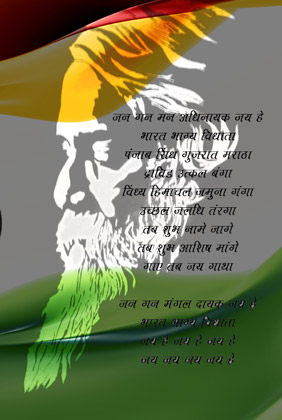Commemorating Independence Day: Fascinating Facts about the Indian National Anthem

Jana Gana Mana…
Those pride-inducing words are woven into the fabric of Indian patriotism. Both the lilt and the lyrics of the national anthem have made it perhaps the first and foremost expression of such pride for Indians.
Though this Bengali invocation had been written in 1911 and sung that year in a session of the Indian National Congress in Calcutta, it had remained largely confined to the pages of the Arya Samaj journal, Tatva Bodha Prakasika, of which Rabindranath Tagore was the editor.
(Above) The dilapitated cottage at the Besant Theosophical College in Madanapalle, Andhra Pradesh, where Tagore is said to have written the first English translation of “Jana Gana Mana.”

(Left) The courtyard in Madanapalle where "Jana Gana Mana" was first sung by Tagore and a group of students in 1919.
It was at the Besant Theosophical College in Andhra Pradesh in 1919 that Tagore and a group of students first sang out “Jaya hai, Jaya hai,” the concluding crescendo of the anthem in unison, a song that reverberated across the campus. Later Tagore wrote the English translation and the score, which is today displayed in the archives of the College. At that time it was called the “Morning Song of India.”
Here are some fascinating tidbits surrounding this dear and revered verse.
There is a perpetuated myth that Rabindranath Tagore
wrote this song for the British monarch.
Tagore refutes this by writing, “In 1911 a certain
high official in His Majesty’s service, who was also my
friend, had requested that I write a song of felicitation
towards the Emperor. The request simply amazed me.
It caused a great stir in my heart.
In response to that great mental
turmoil, I pronounced the victory
in Jana Gana Mana of that Bhagya
Vidhata (the one to determine the
destiny) of India who has age after
age held steadfast the reins of India’s
chariot through rise and fall,
through the straight path and the
curved. That Lord of Destiny, that
Reader of the Collective Mind of
India, that Perennial Guide, could
never be George V, George VI, or
any other George. Even my official
friend understood this about the
song. After all, even if his admiration
for the crown was excessive,
he was not lacking in simple common sense.”
At the Calcutta Congress session which began on December 26, 1911, the second day was apparently devoted entirely to welcoming King George V. “Jana Gana Mana” was sung on this occasion. Thereafter, some newspaper reports claimed that it was in honor of King George V. Since Tagore did not immediately refute the allegation, the perception spread that the song was a eulogy to the monarchy.
The Hindi version
Although he was instrumental in choosing
“Jana Gana Mana” as the Qaumi Tarana (National Anthem)
of the Provisional Government of Free India in
Singapore in October 1943, Netaji Subhas Chandra
Bose did not, however, like the fact that the song was
in Sanskritized Bengali. So he commissioned a free
translation in Hindustani. The translation, “Subh
Sukh Chain,” was written by Captain Abid Ali, and its
score composed by Captain Ram Singh Thakur, head
of the Indian National Army’s music division. He was
best known for his rousing classic, “Qadam barhai
ja, khushi ke geet gai ja.” Netaji wanted to make “Jana
Gana Mana” a martial tune, that soldiers of the Indian
National Army could march to, like “Qadam barhai ja.”
Even though “Subh Sukh Chain” is considered a Hindi version of the national anthem, its meaning varies from the latter and it is, therefore, not a true translation.
The national anthem: born in exile, in Germany
Netaji Subhas Chandra Bose went to Germany
in April 1941 and setup the Free India Centre. It
had a flag similar to the present day Indian Tricolor
but with a springing tiger in the
middle. He also introduced “Jai
Hind” as an Indian form of addressing
each other. The only
thing missing was a national anthem.
Netaji called a meeting
and discussed several options
and ultimately decided that
“Jana Gana Mana” should be the
national anthem of Free India.
There were no notations available,
so Dr. Ambik Majumdar,
who was well versed in musical
notations, wrote the notations
to the song and another
Indian, a Dr. Mukherjee,
played it on the piano for Netaji’s
approval. The final version was then given to
Dr Eigel Kruettge, the conductor of the Radio Symphony
Orchestra of Hamburg, who made some
minor changes to the notation for the orchestra.
This is the version that is valid today.
On the 11th of September 1942, the Radio Symphony Orchestra of Hamburg played the national anthems of Germany and the Free India Centre. This was the birth of “Jana Gana Mana” as the national anthem of independent India. Mr N. G. Ganpulay, a close associate of Netaji and an active member of the Free India Centre, recorded the performance on tape. After his death, this tape was handed over to All India Radio, which broadcast a program in 1980 called “National Anthem Born in Exile.”
Is it compulsory to join with the singing
of the national anthem in public
functions?
In July 1985 in the state of Kerala,
some of the Jehovah’s Witnesses children
were expelled from school under
the instructions of Deputy Inspector
of Schools for having refused to sing
the national anthem, as it was against
the tenets of the religious group. Even
though they desisted from actually singing,
they used to stand up in respectful
silence daily, during the morning assembly
when the national anthem was
sung. A Commission was appointed
and it reported that the children were
“law abiding” and that they showed no
disrespect to the national anthem. However,
under the instructions of Deputy
Inspector, the Head Mistress expelled
the appellants from school from July 26,
1985 and the Kerala High Court supported
her decision.
A parent, V. J. Emmanuel, appealed to the Supreme Court of India for legal remedy. On August 11, 1986, the Supreme Court overruled the Kerala High Court, and directed the respondent authorities to readmit the children into the school. The decision went on to add: “We may at once say that there is no provision of law which obliges anyone to sing the national anthem nor do we think that it is disrespectful to the national anthem if a person stands up respectfully, when the national anthem is sung, and does not join the singing. Our tradition teaches tolerance, our philosophy preaches tolerance, our Constitution practices tolerance, let us not dilute it.”

Lyrics
Jana-gana-mana-adhinayaka, jaya he
Bharata-bhagya-vidhata
Punjab-Sindhu-Gujarata-Maratha-
Dravida-Utkala-Banga
Vindhya-Himachala-Yamuna-Ganga
Uchchala-Jaladhi-taranga
Tava shubha name jage
Tava shubha ashish maange
Gahe tava jaya-gatha
Jana-gana-mangala-dayaka jaya he
Bharata-bhagya-vidhata
Jaya he, jaya he, jaya he
Jaya jaya jaya, jaya he !
Translation
Thou art the ruler of the minds of all people,
dispenser of India’s destiny.
Thy name rouses the hearts of Punjab, Sind, Gujarat and Maratha,
of the Dravida and Orissa and Bengal;
It echoes in the hills of the Vindhyas and Himalayas,
mingles in the music of Yamuna and Ganga,
and is chanted by the waves of the Indian Sea.
They pray for thy blessings and sing thy praise.
The saving of all people waits in thy hand,
thou dispenser of India’s destiny,
Victory, victory, victory to thee.
Enjoyed reading Khabar magazine? Subscribe to Khabar and get a full digital copy of this Indian-American community magazine.
blog comments powered by Disqus










